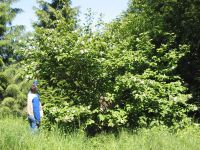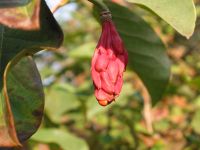Siebolds Magnolia - Magnolia sieboldii
English name:
Siebolds Magnolia
Scientific name:
Magnolia sieboldii
Family:
Magnoliaceae (magnolia)
Height:
up to 4 m.
Flowering:
Late May through August
Range:
Japan, Korea, and China
 |
|
 |
 |
The 27 year old Magnolia sieboldii in this picture is from seed collected at 900 M elevation on mount Daekyu-san in South Korea. The plant borders our Main road soon after the second large grass plain. It is in square 1512 position 3106.
Plant description:
The genus Magnolia comprises about 80 species from temperate and tropical parts of East Asia and America (before the most recent ice ages Magnolias were also found in Europe). The genus name was given by Carl Linnae, and honours a much respected French botanist, Pierre Magnol. This genus contains both evergreen and deciduous species. Species of this genus are noted for producing the largest individual flowers of any temperate woody plant. Magnolias are well known as garden plants, but some have also been used in medicine (M. officinalis for example), to spice food (M. virginiana or sweet bay) and the wood has had many, many uses. We have 7 species of Magnolia growing at Hørsholm and 5 additional species grow in our Forest Botanic Garden in Charlottenlund. This months plant, Magnolia sieboldii, is another one of my favourite plants, because of the beautiful flowers.
The individual flowers of M. sieboldii with the pure white tepals (the sepals and petals combined), reddish stamens (male), and pale yellow or green gynocium (female parts), look so perfect that they almost seem artificial. The mild scent is also much to my liking (the scent is more strongly developed in the subspecies sinensis). After an initial abundant flowering, the flowers come successively one by one over the summer. Magnolia sieboldii is the most common Magnolia in our collection and we have 11 examples. We have 4 different wild-collected provenances from the Nordic Arboretum Expedition to Korea in 1976, but there are only one or two examples from each provenance. The rest of our material is of unknown origin or are of garden origin. Incidentally, the Botanic Garden in Copenhagen has a wild collected specimen from Japan. This species is reported to be the most northerly growing Magnolia in Asia.
Originally named Magnolia parviflora in 1846, the name was changed to M. sieboldii in 1853. This is because the original name had already been used for another plant. It was introduced into Denmark before 1905.
These are deciduous shrubs or small trees have pale yellow autumn leaf colour, and striking red fruits. The broadly elliptic leaves are 10-15 cm long and have entire margins as typical for Magnolias. The subpecies sinensis has a soft dense hair on the under surface of the leaves. The flowers are cup-shaped, up to 7-10 cm across, with 9 tepals, many striking reddish stamens that fade in colour with time, and a yellow or green gynocium. The flowers are more or less horizontally posed so you see them face to face, unlike other Magnolias with up right (in the subsp. sinensis the flowers hang). The fruits hang down and are bright red with orange seed.
This species regenerates relatively easily from seed although it may take several years before germination. It is reported to hybridize with other species, so the seed from garden plants may not come true to type. Magnolia sieboldii also spreads naturally by layering and broad thickets are reported to form in this way. This species is reported to begin flowering at an early age, unlike some magnolias that need many years before flowering when grown from seed. For this and other reasons most garden magnolias are regenerated by grafting or rooted cuttings.
References:
Bean, W.J. 1973. Trees and Shrubs Hardy in the British Isles Vol II. Bean and Murray publishers. 784 pp.
Lange, J. 1994. Kulturplanternes Indførselshistorie i Danmark. (Introduction History of Cultivated Plants in Denmark). Jordbrugsforlaget, Frederiksberg. 458 pp.
Langschwager, L. 1997. Havens Planteleksikon, Træer og Buske; Bind I Det Danske Haveselskab Lyngby. 360 pp.
Treseder N.G., 1978. Magnolias. Faber & Faber London, 245 pp.
